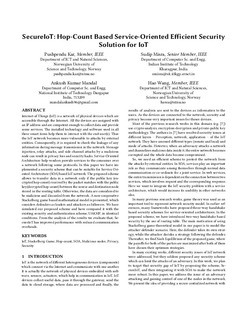SecureIoT: Hop-Count Based Service-Oriented Efficient Security Solution for IoT
Chapter
Accepted version

Åpne
Permanent lenke
http://hdl.handle.net/11250/2595287Utgivelsesdato
2018Metadata
Vis full innførselSamlinger
- Institutt for IKT og realfag [597]
- Publikasjoner fra CRIStin - NTNU [38127]
Originalversjon
FICN '18 Proceedings of the 1st International Workshop on Future Industrial Communication Networks 10.1145/3243318.3243323Sammendrag
Internet of Things (IoT) is a network of physical devices which are accessible through the Internet. All the devices are assigned with an IP address and are competent enough to collect data and provide some services. The installed technology and software used in all these smart items help them to interact with the end-user(s). Thus the IoT network becomes more vulnerable to attacks by external entities. Consequently, it is required to check the leakage of any information during message transmission in the network. Message injection, relay attacks, and side channel attacks by a malicious node can result in privacy loss and security hacks. Service-Oriented Architecture help vendors provide services to the consumer over a network following some protocols. In this paper we have implemented a security scheme that can be suitable for Service Oriented Architecture (SOA) based IoT network. The proposed scheme allows to transfer data in a network only if the public key (encrypted hop-count) received by the packet matches with the public key(decrypted hop-count) between the source and destination node stored in the routing table. Otherwise, the data is considered to be malicious and discarded from the network. A non-cooperative Stackelberg game based mathematical model is presented, which considers defenders as leaders and attackers as followers. We have simulated our proposed scheme and have compared it with the existing security and authentication scheme, UAKMP, in identical conditions. From the analysis of the results we evaluate that, SecureIoT has improved performance with reduced communication overheads.